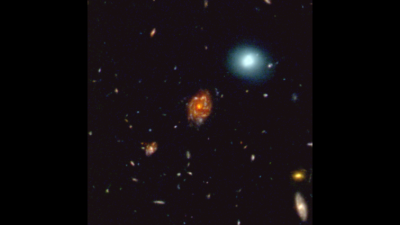‘Big Wheel’ disk galaxy discovered accidentally by international team

'Big Wheel', the disk with the red glow, has been discovered by an international team, including Swinburne's Dr Themiya Nanayakkara.
In summary
- An international team involving Swinburne University of Technology has discovered a giant spiral disk galaxy in the early cosmos
- Galaxy spectral modelling expert Dr Themiya Nanayakkara is a part of the international team that planned the JWST observations, which accidentally discovered this galaxy
- The disk galaxy challenges our existing models of early formation and hints that dense, gas-rich environments may be the cradle for the universe’s earliest giants
An international team involving Swinburne University of Technology has discovered a giant spiral disk galaxy in the early cosmos.
James Webb Space Telescope (JWST) observations accidentally discovered the disc galaxy after targeting a region of the sky from eleven billion years ago, or two billion years after the Big Bang.
Galaxy spectral modelling expert Dr Themiya Nanayakkara says disk galaxies have been an ongoing puzzle in astronomy and the findings will help rethink the nature of cosmic structures.
“This galaxy not only challenges our existing models of early formation but also hints that dense, gas-rich environments may be the cradle for the universe’s earliest giants,” he says.
Using data from two instruments onboard the JWST, Dr Nanayakkara and the team identified key markers needed for the identification of galaxy disks and the galaxies within this structure.
The observation and analysis of redshifts, morphology, and kinematics led the team to the discovery of this surprisingly large disk galaxy.
“This galaxy, dubbed the ‘Big Wheel’ has an optical radius of around 10 kiloparsec, which is at least three times as large as what is predicted by current cosmological simulations,” Dr Nanayakkara says.
Further analysis based on data from the JWST confirmed that the galaxy contains a disk rotating at around 300 km/s. It is larger than any other kinematically confirmed disks found at similar early time periods, and is comparable to the size of today’s most massive disks.
Dr Nanayakkara says the disk lives in a highly over-dense environment, which may indicate favourable physical conditions for early disk formation. There are few galaxies comparable to the Big Wheel in current simulations, so these conditions are not yet captured in galaxy formation models.
“Environments of this kind are known to host frequent galaxy encounters, mergers and gas flows. Therefore, in order to have a disk form early and grow quickly, galaxy mergers in this environment must have been non-destructive and oriented in particular directions.”
Angular momentum of gas flows moving in conjunction with the galaxy disk may also factor into this, Dr Nanayakkara says.
The investigation paves the way to studying this underexplored. With hopes of more targeted observations, Dr Nanayakkara and his team look forward to larger statistical samples and opening new pathways into the study of early phases of galaxy formation.
Swinburne was the only Australian research institution participating in this investigation.
-
Media Enquiries
Related articles
-

- Astronomy
Indigenous students explore the cosmos through Swinburne’s astrophysics program
Indigenous students explored astrophysics at Swinburne, connecting science and culture while building pathways to future careers in STEM.
Friday 19 September 2025 -

- Science
If quantum computing is answering unknowable questions, how do we know they’re right?
A new Swinburne study is tackling the paradox - if quantum computing is answering unknowable questions, how do we know they’re right?
Tuesday 16 September 2025 -

- Health
World-first disease progression model offers new hope for muscular dystrophy patients
Patients with a common type of muscular dystrophy will benefit from a world-first AI powered disease progression model with ‘life-changing’ implications, using advanced MRI imaging at Swinburne University of Technology.
Friday 05 September 2025 -

- Design
Why some clothes shrink in the wash — and how to 'unshrink' them
When your favourite dress or shirt shrinks in the wash, it can be devastating, especially if you followed the instructions closely. Unfortunately, some fabrics just seem to be more prone to shrinking than others – but why?
Tuesday 05 August 2025 -

- Science
Swinburne hosts 2025 National Youth STEM Summit
Over 160 young Australians recently gathered at Swinburne’s Hawthorn campus for the first Melbourne-hosted National Youth STEM Summit. Attendees heard from leading voices in STEM, including Professor Alan Duffy, Professor Misty Jenkins AO, and Dr Doug Hilton AO.
Wednesday 13 August 2025

